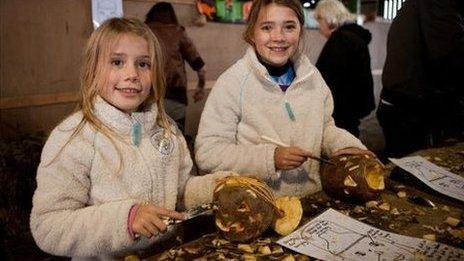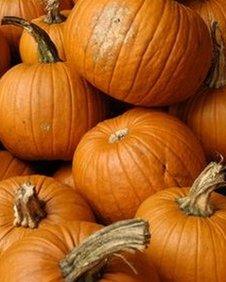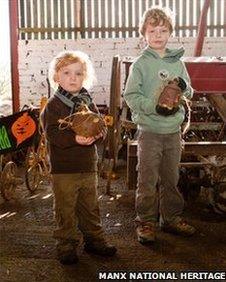What's the difference between Hop-tu-Naa and Halloween?
- Published

Turnip carving is a Hop-tu-Naa tradition on the Isle of Man
As the rest of the British Isles prepares to celebrate Halloween on 31 October, many Isle of Man residents will instead celebrate Hop-tu-Naa.
Historically Hop-tu-Naa has been considered to be the Celtic New Year, marking the end of the summer and the beginning of winter.
It was traditionally a time when people would celebrate the safe gathering of the harvest and was a sign that all preparations had been made for the long, cold winter ahead.
While 31 October may be known to many as Halloween, any Manx person worth their salt will give a stern look and say the festival in question is Hop-tu-Naa.
No connection
This custom of singing around the houses goes back into history, although the turnip lanterns, now irrevocably linked with the practice, only seem to appear about 100 years ago.

Pumpkins are more traditionally linked with Halloween
With the passing of time and mixing of cultures as "incomers" to the island bring their own customs, things do become rather confused and today many see Halloween and Hop-tu-Naa as one and the same.
In reality there is no connection. Hop-tu-Naa is really a celebration of "Oie Houney", the original New Year's Eve.
As such it is a sole reminder of these ancient times and the words Hop-tu-Naa are a corruption of Shogh ta'n Oie, meaning "this is the night".
However, the Celtic New Year was moved to the secular new year on 1 January, a move still remembered in Scotland where "Hogmanay", from the same root words, is still celebrated.
The Celtic year was divided into quarters and Sauin, or new year, was celebrated in Mee Houney, the Manx for November.
Ginnie the Witch
The fact remains, like it or not, that the two festivals are very much linked for many young practitioners.
How many Hop-Tu-Naaers know the words to the traditional Manx Gaelic song?
The answer is very few - although it is to be hoped a recent resurgence of interest in Manx Gaelic and the formation of a Manx speaking play group and primary school may help rectify this situation.
Today the chances are you will be treated to a rendition, or more likely part-rendition, of Ginnie the Witch, a song which seemingly adds to the confusion between Hop-tu-Naa and Halloween despite having been around for a good number of decades.
If you are less lucky, you may be assailed with another presumably none Manx variant, The Witches of Halloween, but few will be serenaded with the original Manx Song Shoh Shenn Oie Houiney, Hop-tu-Naa, T'an Eayst Soilshean, Trol-la-laa or This is old Hollandtide Night/The Moon Shines Bright.

Children with their turnip lanterns at Cregneash in 2009
And what of the lanterns? A proper Hop-tu-Naaer will have a hollowed out turnip the size of a man's head, with flickering eyes and jagged mouth illuminated from within by a candle.
Burning turnip
A good turnip lantern is worth a pound of anyone's money, safe in the knowledge that someone, though probably not the little cherub on your doorstep, has suffered sprained wrists and blistered thumbs scooping it out.
Tragically there is now a much-preferred soft option, the pumpkin.
True, they make very nice lanterns but they are really not in the same league. Cut the top off, turn it upside down and the insides practically fall out.
This American import goes hand-in-turnip with that other transatlantic custom, Trick or Treat, in which a devil mask and bin liner are all that are needed to do the rounds, with the threat of a trashed flowerbed if the homeowner is not forthcoming with a treat.
Three customs muddled into one night - it can only be the Isle of Man.
Hop-tu-Naa, it seems, has a confused present and an uncertain future, but it is to be hoped it does survive; a generation of children deprived of the smell of burning turnip would be a poorer one indeed.